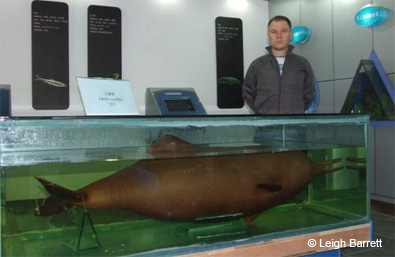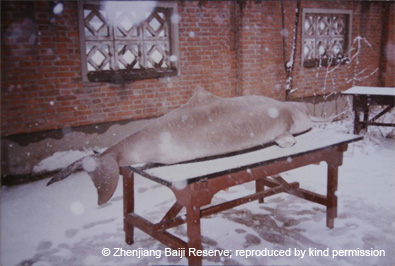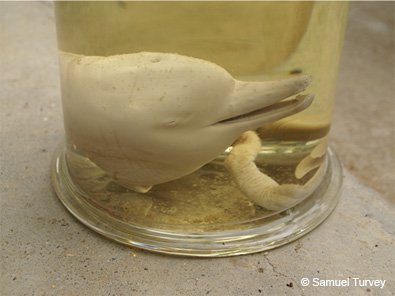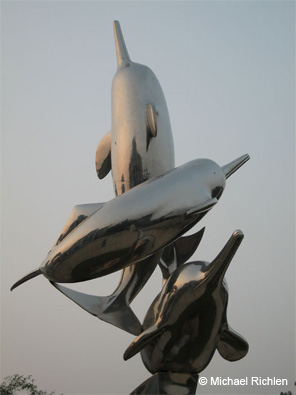Here is the final blog from EDGE’s Dr Sam Turvey about his surveys along the Yangtze River in China, trying to discover the cause behind the disappearance of the baiji, and declines in other Yangtze species.
The Yangtze River dolphin or baiji is unique in many ways. It is the only representative of an entire mammal family, the Lipotidae, which diverged from all other river dolphins around 20 million years ago. It is our top-ranked EDGE mammal. And, quite possibly, it is the first species of cetacean – the group containing all whales, dolphins and porpoises – to have become extinct as a result of human activities. An exhaustive survey of the baiji’s former distribution in the middle-lower Yangtze in 2006 failed to find any surviving dolphins anywhere in the river, and the only possible evidence of the baiji’s continued survival since then has been a poor-quality, highly suspect video film which probably shows a finless porpoise rather than a dolphin, if indeed it shows anything at all.
I spent much of 2008 in China, helping to co-ordinate a survey of fishing communities along the middle-lower Yangtze that aimed to gather any recent baiji sighting reports as well as any other ecological information or local memories about the species – in order to assess the likelihood that the baiji really was gone. During this survey, we interviewed almost 600 fishermen, and obtained tremendous amounts of data on the wider-scale ecological collapse that is currently taking place in the Yangtze ecosystem as a result of dam construction and industrialisation, rampant pollution and overfishing. But what did these fishermen, who spend their entire lives along the river, have to tell us about the existence or survival of the iconic dolphin?
The great majority of the fishermen that we spoke to had heard of baiji, or had seen it in years gone by. We learnt a great number of local traditions about dolphins – one informant told us that the baiji was locally known as the ‘girl fish’, because it was as shy as a girl at a party, and would swim away rapidly if anyone called out to it. Some fishing communities considered it to be a lucky animal, whereas others, in marked contrast, thought that it was bad luck to see a baiji or to talk about the animal at all. It has been widely reported that the baiji is considered to be the reincarnation of a drowned princess – a story which serves to make its demise even more poignant – but one story that we heard repeated all along the river had a much more bitter plot. The baiji was originally a girl who had been forced into prostitution (to work in a ‘meat factory’, to use the local euphemism), and had unwittingly slept with her father. Drowning herself in shame, she turned into a pure white dolphin.
Despite all of these local myths and legends, though – and once again in marked contrast to international perceptions that the species was venerated by local communities – old fishermen all along the river told us how they had killed and eaten baiji in the past. We learnt many recipes for cooking baiji, but nearly everyone we spoke to told us that the animal had tasted foul and was far too oily to eat. Most of the times when fishermen had eaten baiji had been several decades ago, though, during the time that China was wracked by great country-wide purges and famines. The fishermen tried to eat baiji simply because there wasn’t much else to eat.
But were there any baiji left, anywhere out there in the vast expanse of the world’s third longest river? If anyone could tell us, it would be these fishermen. Most of the informants that we spoke to reported that they regularly saw finless porpoises, the other cetacean species found in the river. In contrast, most of them hadn’t seen baiji for 20 years or more. This extreme contrast in sighting dates for the two species suggests that, even if a few dolphins had survived until more recently, the species was already in critical decline and was possibly already functionally extinct a couple of decades ago. We know that at least a few baiji survived in the Yangtze into the start of the twenty-first century – the last reported stranding was in 2001, and another animal was photographed by Chinese researchers in 2002 – and a few fishermen also reported that they’d seen dolphins during the past decade. But these claims were few and far between, and most of the reports were already several years old. If there were any baiji left, then where had they been for the past few years? A couple of the reports were more recent, and we went out on the river and surveyed the river sections where these dolphins had supposedly been seen. The pattern was the same – we never found anything.
We wanted to find evidence that the baiji might still survive, that yet another beautiful, iconic, unique mammal species hasn’t been lost forever. But all we found were rumours and ghosts. All along the river, baiji statues and murals have been built – to mark the boundaries of protected reserves, to commemorate the charismatic species that had once lived in the Yangtze – using conservation money that should have been spent on active efforts to protect the species. But now it’s too late. The river is empty. The baiji is gone.




